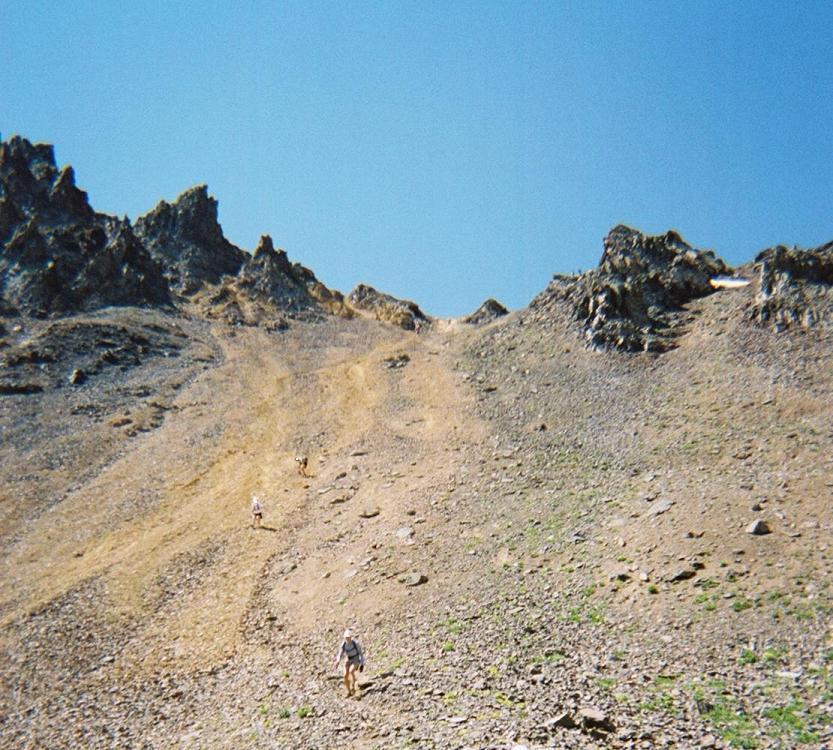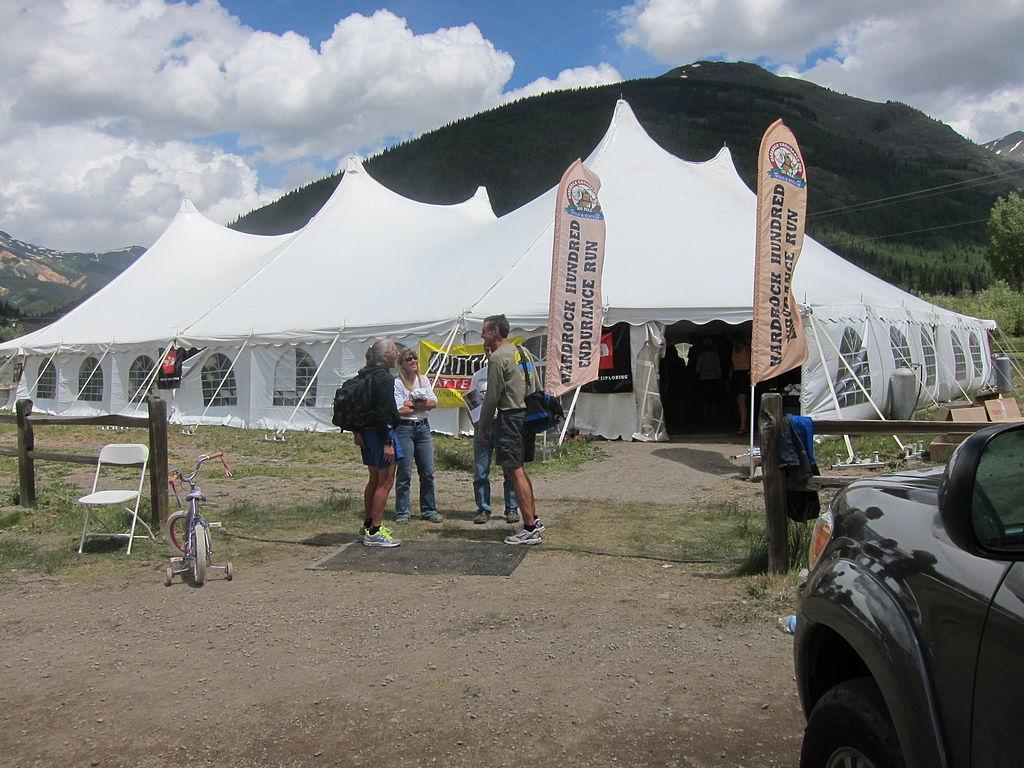Hardrock Hundred Endurance Run
Full Article
The Hardrock Hundred Endurance Run is a famously difficult and beautiful 100-mile trail race held annually in the San Juan Mountains. First organized in 1992, soon after the Sunnyside Mine shut down, the event honors the region’s mining history and its fragile high-alpine environment by taking participants on a loop course through Silverton, Telluride, Ouray, and a host of ghost towns and mine ruins. As ultrarunning became more popular and commercialized in the early 2000s, Hardrock’s organizers have tried to maintain the event’s familial atmosphere and environmental focus.
Origins
Gordon Hardman first hatched the idea for a 100-mile trail-running race through the San Juan Mountains in 1991. That November, UltraRunning magazine published a letter from Hardman seeking supporters to start such a race. He received a response from John Cappis, who volunteered to help plot the course. The original plan was to chart a loop linking the San Juans’ four main towns—Lake City, Ouray, Silverton, and Telluride—with the start and finish, rotating annually among the towns. Because Lake City lies much farther east than the other three towns, the course was routed through gulches above the town but not through the town itself. After a tentative course map was completed in January 1992, Charlie Thorn helped secure permits and plan the event. In June, after snow started to melt from the high-altitude course, Cappis and Thorn went over the whole loop on foot to make sure it was feasible, often scouting sections in the company of mountain runners Rick Trujillo, David Horton, and Nancy and Rick Hamilton.
With the course measured and flagged, the first Hardrock Hundred Endurance Run was held July 10–12, 1992. It started and finished in Silverton. The run had forty-two starters, including six women, and eighteen runners finished the loop within the forty-eight-hour cutoff. David Horton finished first with a time of 32 hours, 34 minutes, while Nancy Hamilton was the first of two female finishers in 45 hours, 47 minutes. Silverton showed much more interest in the event than shown by the other towns, in part because local economic activity had just taken a hit with the closure of the Sunnyside Mine. Organizers decided that the run would always start and finish there but that the direction would alternate each year: clockwise one year, counterclockwise the next.
Course
The Hardrock course is prized among ultrarunners for its beauty, difficulty, and thoughtful design, which takes runners through drainages and over passes to connect Silverton, Telluride, Ouray, and numerous mining ghost towns on a mix of trails and dirt roads. Runners do a total of 66,000 feet of climbing and descending during the run, including an ascent of a Fourteener, Handies Peak. The course’s average altitude is about 11,000 feet.
In clockwise years, runners start by heading west from Silverton to the former mining town of Ophir and then on to Telluride at about mile 28. From Telluride, a lengthy climb and then a long dirt-road descent take runners into Ouray, which is both the lowest point on the course (7,870 feet) and a rough halfway marker (44 miles). Embarking on the second half of the course, runners head southeast on the Bear Creek National Recreation Trail. After passing through the ghost town of Animas Forks, runners climb to the summit of Handies Peak (mile 64), the high point on the course at 14,048 feet. They then cross the Continental Divide three times before finally heading down to the Animas River and passing near the old Shenandoah-Dives Mill as they make their way back into Silverton to finish the 100-mile loop.
The Hardrock course traverses extreme terrain and is subject to extreme weather. Summer thunderstorms often force runners to huddle at tree line or risk being struck by lightning. There is usually some snow on the course, even in mid-July, but exceptionally heavy snowfall canceled the run in 1995. At the other end of the spectrum, abnormally dry conditions canceled the run in 2002 because of extreme fire danger. In 2019 the run was canceled because heavy snowfall had caused significant avalanche damage along the course.
Notable Performances
Hardrock bills itself as a run, not a race, and focuses on fostering a community of support for all participants attempting to complete the strenuous loop. Nevertheless, records are kept and winners recorded. In 2001 Hardrock entered a new competitive era when Karl Meltzer won the run in 26:39, lowering the course record by nearly three hours. After Meltzer returned to win several more times over the next few years, Scott Jurek won in 2007, lowering Meltzer’s course record to 26:08. The very next year, twenty-three-year-old Kyle Skaggs trained specifically for Hardrock and accomplished what many ultrarunners consider among the finest performances in the sport. Winning in a time of 23:23, Skaggs became the first person to complete Hardrock in under twenty-four hours, besting the previous record by nearly three hours and outpacing that year’s second place by more than six hours.
In the 2010s, Hardrock attracted an increasing number of elite European entrants, most notably the Catalan mountain runner Kilian Jornet, generally regarded as the best of his generation. Jornet first came to the run in 2014 and promptly set a new course record of 22:41. Jornet returned each of the next three years and recorded three more wins. He has four of the run’s top eight times and three of the six times under twenty-four hours.
In general, Hardrock has been less competitive on the women’s side because of the small number of female entrants. Betsy Kalmeyer dominated the run’s first fifteen years, recording five wins as well as the first women’s time under thirty hours in 2001. Since the mid-2000s, the women’s run has seen several winning streaks: Diana Finkel won four years in a row, then Darcy Piceu recorded a “threepeat,” and Anna Frost repeated as winner in 2015–16. In 2009 Finkel recorded the top women’s time of 27:18.
Today
As trail running and ultrarunning became more popular in the early 2000s, Hardrock faced a conundrum common to many events of its kind—how would a run that prized its familial feel and environmental ethic handle exploding interest and increased commercialism? Sponsors became more prominent at Hardrock in the 2010s, but the run’s remote location and purposefully small field of only about 145 starters—chosen to limit the event’s environmental impact—impose stringent constraints on future growth and change.
Indeed, perhaps the most controversial aspect of Hardrock today is the lottery process by which it selects starters from a pool of more than 2,000 applicants. Two-thirds of the entry slots are reserved for runners who have completed Hardrock before, including more than thirty slots for runners who have completed the race at least five times. This process is intended to promote continuity and community, but it has the practical effect of making it difficult for the large number of people who have never run the race to ever get in. As a result, some see the run as an insular old-boys’ club. The lottery’s preference for previous participants also perpetuates the extreme gender imbalance that has long characterized the field, which typically includes about 125 men and only 20 women.






























